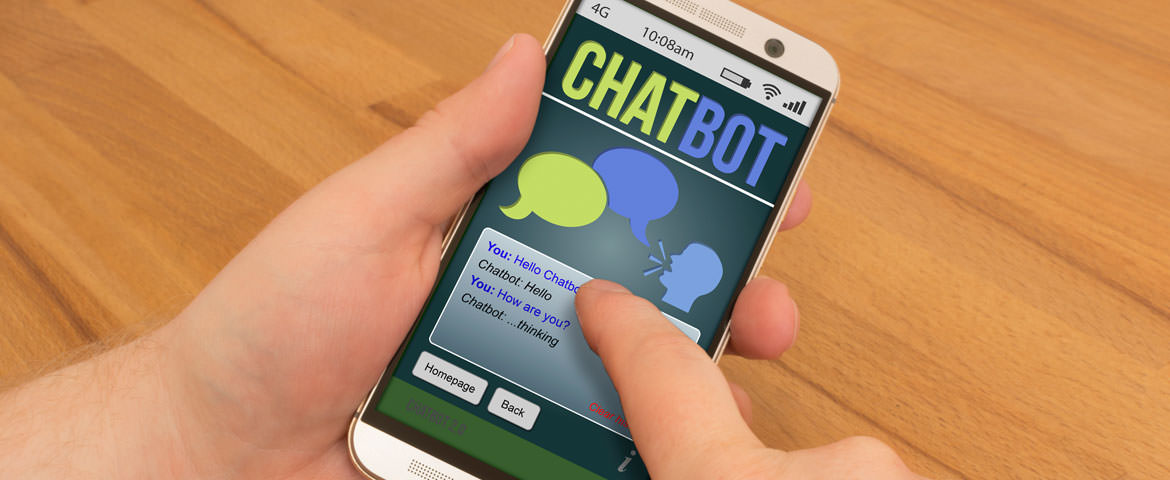Lead generation is one of the main activities done by marketing professionals. It involves choosing the right channels, tools, and platforms. In recent months, chatbots have emerged as a new trend. Chatbots are robots which can hold a fully or partially automated conversation. This type of artificial intelligence feeds off big data and has the potential to become one of the most effective lead generation tools. Chatbots can be added to your website or feature within messaging tools like Messenger, WhatsApp, Skype and LINE. They are already being used by a range of brands. They can operate 24 hours a day, 365 days a year and automate the lead generation process for you. Information, advice and good practice.
Set your chatbot a goal
A simple reminder to begin: there’s no point having a chatbot just because its “on-trend” if it doesn’t actually add anything to the user experience. Yes, we may be hearing more and more about chatbots, they’re proving their worth and they can help ease the commercial strain. But the main question is: how can a chatbot help you? How will your chatbot work within your overall strategy? What are your goals? Do you want to start conversations and get people interested? To answer visitors’ questions? To help your support service?
It’s important to work out what you want your chatbot to achieve as this will enable you to draw up an implementation plan and calculate your return on investment (ROI).
Choose the right platform
Once you’ve decided what you want your chatbot to achieve, you’ll need to choose where to put it. Most chatbots are part of messaging apps like Messenger, WeChat, and Twitter. However, they can also be added to a website. You’ll need to look carefully at your buyer personas, visitor behavior and social media presence to choose the perfect platform. For example, Messenger is probably not the best solution for B2B. Therefore, if you have an active Facebook community, it may be just the thing.
Choose the right tool to create your chatbot
As with websites, there are various different options when it comes to building a chatbot. But do you have the time, energy and skills internally?
Certain SaaS platforms can make a chatbot for you. All you need to do is provide the content. Here are some examples:
- Aivo: a customer service solution.
- Botsify: for Messenger or website chatbots.
- Chatfuel and ManyChat: popular and easy-to-use solutions for Messenger.
- Flow XO: a comprehensive tool which can be integrated with all major platforms.
If you’d rather get someone in to create, integrate and implement your chatbot, you’ll need to look for an expert in the field or a partner agency. You may find it saves time to use external skills which can potentially take the chatbot further than internal colleagues. If you have complex personalization needs, this could well be the solution for you.
Create your content
Although some chatbots are intelligent (or semi-intelligent), most deliver pre-programmed conversation. Meaning that your chatbot’s content is key. If it is clear and well-thought-out, it can boost conversions. Therefore, you’ll need to spend plenty of time writing scripts and creating decision and interaction trees. It’s the same principle as with books where you’re the hero. An interaction equals a decision. You have to start off broad, then narrow down little by little. Furthermore, replies need to be precise and closed and be part of a comprehensive decision tree. If a person answers A, B or C to a question, what will happen next? Such instructional design will give your chatbot an almost “human” feel.
Integrate with existing tools
To be effective, chatbots will need to be integrated with your existing infrastructure and processes. A long list of integrations can be required, including CRM, DMP, product catalogs, Google Analytics, cross-device tracking, etc. The more internal and external data a chatbot can access, the more effective it will be. Configuration takes time and should be considered at the creation stage.
If your goal is to optimize lead generation, you should organize data collection accordingly. Chatbots do not exist in a vacuum. They are connected to your tools and are a key part of your team. They also enable you to collect insights to help you measure your return on investment more effectively.
Promote your chatbot
Once your chatbot is up and running, you’ll need to make sure people know about it. You could think about running a promotional campaign. Here are some examples:
- Send out a marketing email to introduce your chatbot.
- Personalise your chatbot (name, lifestyle, etc.) to create a compelling story around this new virtual character.
- Offer discount vouchers or promotional coupons to early chatbot users.
- Organise a competition on social media.
- Provide a premium service to those who get in contact or buy via the chatbot.
- Get feedback from early users and reward them for it.
Chatbots: use and good practice
Answers to faqs
The simple and conventional interactions that a chatbot might deal with to avoid your prospects having to search the web for information could include store opening hours, current promotions, questions about products sold or offers accessibility or parking.
They can also help provide a support service. Chatbots can also filter questions, focusing on those with low added value. Other queries can then be dealt with by call center agents via the messaging app or other channels.
To manage delivery, confirmations, and availability
With a chatbot, micro-interactions can be automated. Examples include reviewing orders, sending purchase confirmations, notifying of imminent deliveries and confirming that returns have been received. The information is stored in the same place and is often easier to access than email. Therefore, users can even interact with post-sale (move delivery, ask a question about payment, etc.).
To engage your community
Chatbots are conversational tools which can be fun to use and boost engagement. As a result, you can use them for educational purposes, to run tests or quizzes and to organize games and competitions. They can also add a touch of humor to proceedings with jokes and puns. You can set them up to match your editorial style and creativity.
To place an order
If your product range isn’t overly extensive, you can use a chatbot to place orders or book appointments. Pizzas, hairdressing, ready-to-wear, clothing, make-up, wellness, train tickets, plane tickets, show tickets…almost anything is possible! Your chatbot can also provide tutorials and explain the good practice. For example, you could have it demonstrate how to put together a piece of furniture, use software or improve user health: the possibilities are endless!
To collect leads
A new way to collect qualified leads. Because chatbots work using conversation, you can identify the ideal user by asking filter questions. You can then use their answers to these questions to suggest the right services and/or products. This represents an alternative to conventional co-registration.
Chatbots are already being fully integrated into major brands’ systems. However, the good news is that they are accessible to all. Whatever your budget and size and whether you are aiming at internal or external use, chatbots will change how you work and optimize your marketing strategy.
Want to read our chatbot lead generation case studies? Contact our sales team!
 SKALE
SKALE  Join Kwanko
Join Kwanko  Program Directory
Program Directory  Who is Kwanko
Who is Kwanko  History
History  Careers
Careers  Kwanko Academy
Kwanko Academy  News
News  Case Studies
Case Studies  Strategy and commitment
Strategy and commitment  Social Responsability
Social Responsability  Gender Equality
Gender Equality  Our Environmental Charter
Our Environmental Charter  Our Ethical Charter
Our Ethical Charter  Our responsible purchasing policy
Our responsible purchasing policy  Certifications and Publications
Certifications and Publications 


 Publishers
Publishers Advertisers
Advertisers Our Solutions
Our Solutions  About Us
About Us  Academy
Academy 













